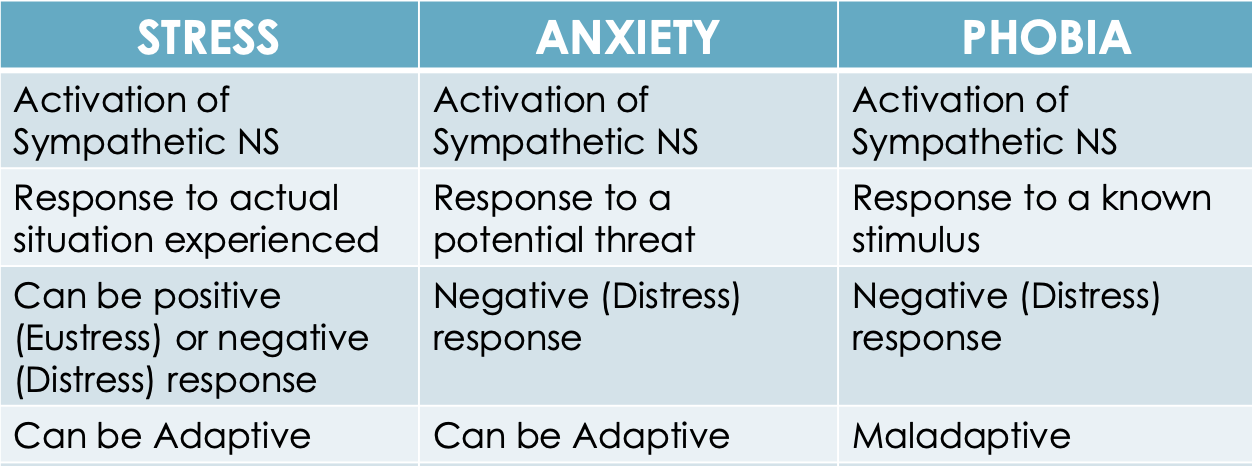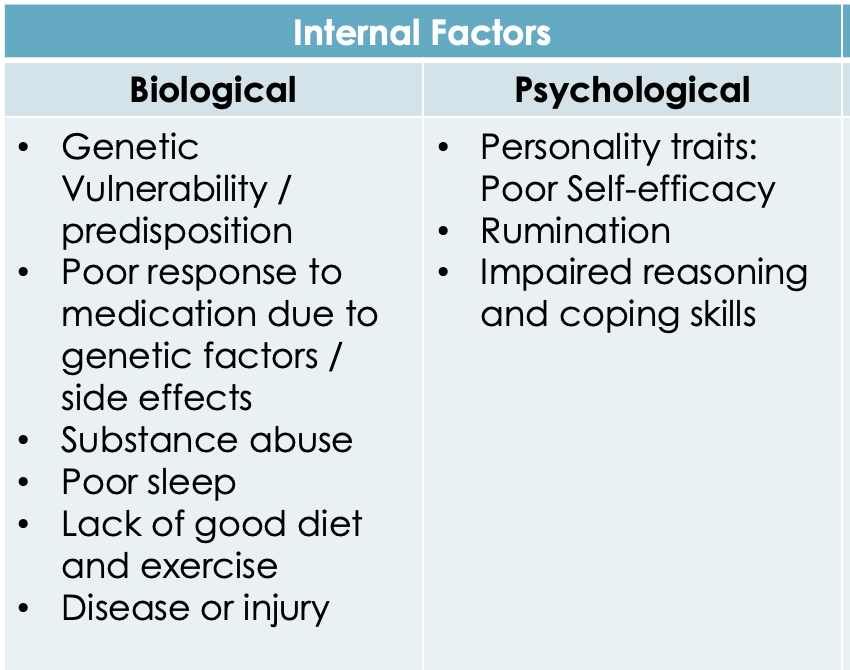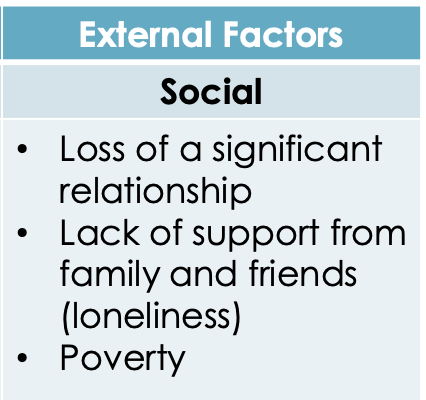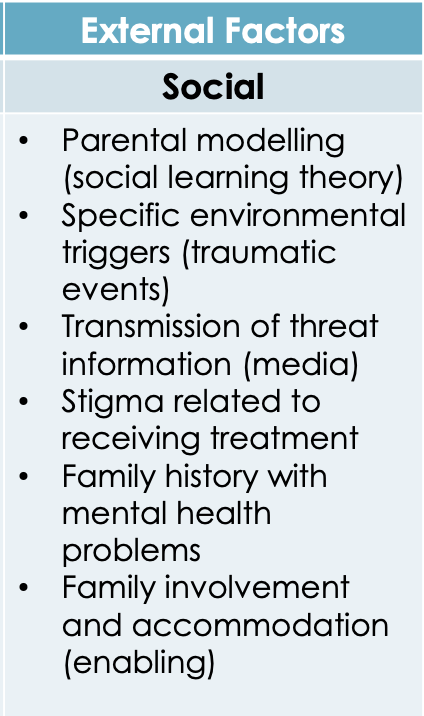U4 AOS 2 - Mental Wellbeing
1/86
There's no tags or description
Looks like no tags are added yet.
Name | Mastery | Learn | Test | Matching | Spaced |
|---|
No study sessions yet.
87 Terms
mental health
a positive state of wellbeing where people
are productive and able to function efficiently on a day to day basis
have healthy confidence and self-esteem
interact well with others an their environment in an appropriate and adaptive way
mental health continuum
degrees of severity between positive and negative states that can fluctuate over time
not black and white
mental healthy
implies optimal performance across all aspects of life, functioning at a satisfactory level of emotional and behaviour adjustment
psychological wellbeing
able to cope with normal stressors
able to form positive relationships
mental health problem
can disrupt individual’s thoughts, feelings or behaviours for a short period of time
mild to moderate stres
temporary impairment
difficulties in coping
some changes in sleep patterns
difficultiy concentrating
mental health disorder
a condition that affects everyday functioning and causes distress for a prolonged duration
psychological dysfunction
marked distress
ongoing impairment
excessive anxiety
common characteristics of mental disorder
psych dysfunction
distress
impairment - decreased ability to meet demands of daily life
atypical behaviours - responding in ways that are unusual, uncommon or inappropriate
mental health influenced by internal factors
biological - genetic inheritance, neurotransmitter/hormone activity, substance use
psychological - attitudes, beliefs, decisions, emotions, learning & memory
mental health influenced by external factors
social - interpersonal relationships, family, friends, cultural traditions, support networks
environment - poverty, pollution, access to community services & natural resources
characteristics of mentally healthy person
high level of functioning
social and emotional wellbeing
resilience to life stressors
high levels of functioning
how well an individual can independently operate in their environment , evident by adapting to and meeting the demands of daily life
independently productive - meeting daily demands
daily living skills - hygiene, eating, dressing, commuting
interpersonal activities - managing relationships and interacting well with others
productivity and goal achievement - high self-efficacy
opposite is no high levels of functioning
adaptive behaviour
an ability to change one’s behaviour to meet the daily demands of everyday life
maladaptive behaviour
refers to a disruption or impairment to one’s ability to carry out daily tasks in an effective way
biopsychosocial framework
approach that considers the holistic combination and interaction of these three domains ensures nothing is ignored in diagnosis and treatment
resilience to life stressors
the ability to cope and adapt to life stressors and the capacity to maintain or restore positive functioning
resilient people have
effective communication skills
emotional awareness
social competence
problem solving skills
sense of self-confidence and belief
resilience & mental health can be improved by
connecting with others
establishing healthy diet, exercise and sleep routines
mindfulness exercises/ living in the moment
challenging yourself
social & emotional wellbeing
refers to our mental state of mind and feelings we have towards ourselves and our lives in general
social wellbeing - having meaningful and satisfying interactions with others
developing & maintaining healthy relationships
respecting different individuals and cultures
resolving conflicts with loved ones
emotional wellbeing - the ability to express and control our feelings appropriately and effectively
awareness and understanding of our emotions as they are experienced
ability to regulate and manage emotional responses
domains of SEWB
body
mind & emotions
family & kinship
community
culture
country
spirituality & ancestors
SEWB - body
feeling strong, healthy, able to participate fully in life
risk factors
alcohol, smoking, drugs
poor diet
lack of housing/medical resources
protective factors
healthy diet and exercise
hunting and gathering on Country
access to culturally safe health care
SEWB - mind and emotions
ability to manage thoughts and feelings
risk factors
unemployment
over-incarceration
social disadvantage
protective factors
education/belonging
access to culturally safe health care
SEWB - family & kinship
interpersonal relationships with respect for reciprocity and sharing between generations
risk factors
domestic violence, neglect, grief
lack of access to education
protective factors
education/adequate income
connection to elders & family
SEWB - community
interpersonal relationships with respect for reciprocity and sharing between generations
risk factors
domestic violence, neglect, genocide
lack of access to education
social exclusion
protective factors
education/income
connection to elders and family
cultural practices including yarning circles etc.
SEWB - culture
elders pass on traditions with a sense of continuity to connect past with present and future
yarning circles, dance, song, ceremony, fire managemnt
risk factors
death of elders, unable to transmit knowledge
genocide
protective factors
cultural institutions, education and events
SEWB - country
underpins identity and sense of belonging
risk factors
removal and lack of access to country
environmental degradation, pollution of land and waterways
destruction of sacred sites
protective factors
land rights and sovereignty claims
traditional land management and protection practices
SEWB - spirituality and ancestors
traditional belief systems provide sense of purpose and meaning & connect past to present and future
risk factors
reduced spirituality and loss of ancestral knowledge from assimilation
intergenerational trauma
protective factors
contemporary expressions of spirituality and mindfulness practices
more opportunities to attend cultural events and ceremonies
SEWB - cultural determinants
strongest protective factors for indigenous people’s social and emotional wellbeing
connection to country and community
self-determination and Indigenous psychological systems that privilege indigneous
SEWB - historical determinants
include ongoing influence of past events, policies, and intergenerational trauma
oppression & displacement from colonisation
SEWB - political determinants
the distribution of resources and power such as land rights, cultural security and promoting human rights for self-determination
SEWB - social determinants
the circumstances by which people grow, live and work, such as the impact of poverty, unemployment, housing, incarceration, education and discrimination
ensuring equity
stress
a physiological and/or psychological state of tension and arousal
stress vs anxiety vs phobia

mentally healthy —> mental health problem: stress/anxiety
mental health disorder = anxiety disorders, specific phobia
anxiety
a state of physiological arousal associated with feelings of worry or uneasiness that something wrong or unpleasant is about to happen
can be adaptive as it activates the sympathetic fight/flight response
however, if level of anxiety is counterproductive and impacts our ability to function effectively, it is problematic
severe anxiety
usually accompanied by intense physiological reactions that interfere with out ability to think clearly and act appropriately
anxiety disorders (& types)
characterised by chronic feelings of apprehension, fear, stress and unease
generalised/non-specific (long-lasting unease)
panic attacks (short terror episodes)
obsessive compulsive (repetitive thoughts & actions)
social anxiety (avoiding interactions)
post-traumatic (following a specific event)
specific phobias (irrational fear of stimulus)
phobia
persistent, intense and irrational fear of an object or event that is maladaptive and causes dysfunction
usually result in high levels of distress and anxiety
stress & anxiety - internal (bio & psych) factors

stress & anxiety - external (social) factors

phobias - internal factors

phobias - external factors

4P
predisposing
precipitating
perpetuating
protective
risk vs protective
protective - alleviate
risk - excacerbate
predisposing factors
underlying susceptibility that could lead to or increase vulnerability to develop mental disorders
family history (inherited genetic traits)
poor physical health (chronic illness often linked to mental unwellness)
neglect, abuse or trauma
disorganised attachment (inability to form secure relationships due to poor emotional development)
poor self-efficacy (low confidence in your own abilities to achieve goals)
precipitating factors
triggering events that can induse mental illness
substance abuse (addiction to drugs or alcohol could result in awakening dormant symptoms)
stressful life events (job loss, death of a loved one)
confronting news (disturbing media reports)
poor sleep
perpetuating factors
prolongs suffering
poor response to medication
avoidance behaviours (ignoring symptoms, denying issue, rejecting help)
rumination (negative ‘overthinking’)
lack of social support
unemployment
protective factors
minimise negative/maximise positive effects
resilient attitude
positive social experiences
physical health (diet, exercise and sleep)
stability & security (employment and accommodation)
specific phobia
irrational fear of a certain stimuli that often leads to
avoidance behaviour - going to great lengths to minimise potential encounters
panic attacks - sudden terror episodes (physiological manifestation)
anticipatory anxiety - rising sense of fear from overthinking the possibility of exposure
stimuli include:
animals (snakes, spiders, birds)
situations (public speaking, confined spaces)
environmental conditions (injections, blood, vomiting)
biological contributing factors - gaba dysfunction
gaba dysfunction - disruptions to balanced neurotransmitter activity can often impact our responses and play a major role in our experience of anxiety
without calming, inhibitory effects of GABA, glutamate dominates which means the activation of PS neurons might get out of control leading to overstimulation and anxiety
fight-flight-freeze responses are more easily triggered with less GABA
can result from:
a lack of GABA being released
inability for GABA to bind to receptor sites
the over production of glutamate
biological contributing factors - long-term potentiation
the strengthening of neural pathways as a result of learning through experience
Watson’s Little Albert Experiment when an infant was taught to fear a white rat by repeatedly associating it with a scary noise over time
phobias are usually learned responses, hence LTP neurologically increases the synaptic connection between the phobic stimulus and the fear response
amygdala plays a crucial role in acquisition and expression of emotional fear responses
psychological contributing factors - behavioural models (two factor learning theory)
precipitated/developed by classical conditioning (repeated association)
perpetuated/maintained by operant conditioning (rewards and punishment)
precipitation by classical conditioning
development of a specific phobia occurs when a neutral or unconditioned stimulus (NS/UCS) is repeatedly associated with an irrational, unconditioned fear response (UCR)
hence, an unreasonable, exaggerated sense of harm, danger or unpleasant outcome, the fear response (CR) becomes triggered by something irrelevant and benign (CS)
e.g.
clouds (NS)
storm (UCS)
irrational fear (UCR)
clouds (CS)
irrational fear (CR) of dying in storm
perpetuation by operant conditioning
avoidance strategies are an example of how negative reinforcement maintains specific phobia
negative reinforcement increases the likelihood of repeating a certain behaviour by removing an unpleasant stimulus, resulting in you feeling better (positive outcome) but remaining scared of it
positive reinforcement increases behaviour by providing a reward
psychological contributing factors - cognitive bias
cognitive models - refer to how individuals perceive, think, feel and act towards phobic stimuli based on experience, memories, appraisals, attitudes, expectations & abilities
phobias - result of cognitive bias
memory bias
catastrophic thinking
cognitive bias
the tendency to think in a way that involves errors of judgement and faulty decision making
cognitive bias - memory bias
‘selective memory’
refers to the distortion of present thoughts, actions and feelings by inaccurate recollections of previous experience
suggests we remember negative information more readily than positive information
reconstruction of past autobiographical memories becomes embellished and exaggerated to justify the irrationality of the fear
cognitive bias - catastrophic thinking
conceptualising and believing worst case scenarios - magnifying the negatives and ignoring the positives
social contributing factors
specific environmental triggers
parental modelling
stigmatisation
social contributing factors - specific environmental triggers
direct negative experiences or traumatic events involving a specific stimulus will result in a phobia to it
social contributing factors - parental modelling
Bandura’s social learning theory - suggests we model our responses off those we observe
if we see others react with fear to stimuli, we might learn to respond in the same way
parents’ phobias, media representations
social contributing factors - stigmatisation
refers to the negative attitudes and discriminatory behaviour targeted towards and experienced by sufferers of mental illness
labelling someone with a diagnosis or putting them into a category of disorder often results in them being though of and treated differently
acts as a barrier to seeking treatment
perceptions of weakness
preceptions of dangerousnness
feelings of guilt, shame, embarrassment, low self-esteem
social contributing factors - stigma around seeking treatment
because phobias are irrational may sufferers are overreacting or exaggerating their experience and don’t take their condition seriously
embarrassed to ask for help
disapproval or disbelief of the impact of specific phobias by others can exacerbate the condition
biological interventions
medication - benzodiazepines
breathing retraining
biological intervention - benzodiazepines
act as GABA agents/agonists that amplify the impact of GABA’s inhibitory effect
work by attaching to receptor sites on the post synaptic neurons, making them less likely to fire
reduces the excitability of neurons reduces communication between them = calming effect/relaxation
benzodiazepines side effect/weakness
can be highly addictive & therefore are not recommended for long-term use
treat symptoms but not the cause
biological intervention - breathing retraining
teaching correct breathing habits helps manage abnormal respiration experienced when exposed to the phobic stimulus
breathing rates increase when we’re afraid
people with specific phobia can often develop abnormal breathing patterns
excessive or over-breathing can upset the balance of oxygen and carbon dioxide in the blood
psychological interventions
cognitive behavioural therapy
systematic desensitisation therapy
psychological interventions - cognitive behavioural therapy
implies that changing the way a person thinks will change their actions
replacing maladaptive thoughts & behaviours with adaptive thoughts & behaviours to help people overcome their fear response
exposure to the threat object is usually rare and that catastrophic thinking is not based on reality.
good for cognitive biases
psychological interventions - systematic desensitisation
a person is progressively exposed to the fear inducing stimulus in a series of steps under relaxed conditions
assumes most phobias are acquired to classical conditioning
therefore, eliminating an irrational fear can be achieved through counter-conditioning/weakening the association between the conditioned stimulus and the conditioned response
systematic desensitisation - steps
teach relaxation technique (breathing retraining) to decrease physiological symptoms of anxiety
establish a fear hierarchy - ranking anxiety inducing incidences from most anxiety-inducing to least anxiety-inducing
systematically (step by step) and gradually pairing the items on the fear hierarchy with the relaxed state until the anxiety response is extinguished
social interventions - psychoeducation
provides information to the client, their family and friends to better understand the condition, symptoms and treatment options available
challenge unrealistic or anxious thoughts (links to CBT)
establish balanced and rational perspective
not encouraging avoidance behaviours (links to systematic desensitisation)
help family & friends understand avoidance behaviours are common but maladaptive
find opportunities for the client to encounter stimulus (gradual exposure)
biological risk - genetic vulnerability
individuals can inherit physiological predispositions to certain disorders
family history does not guarantee susceptibility (not causal)
biological risk factors - medication
some people have greater resistance to certain medications - drugs may not work or not in the way intended
side effects may result in people not taking medication
can be predisposing or perpetuating
biological risk factors - sleep
bidirectional link between sleep quality/quantity and mental disorders
biological risk factors - substance use
50% of people with mental disorders are affected by substance abuse
drugs used to self medicate
drugs can trigger (precipitate) and prolong (perpetuate) a disorder
psychological risk factors - rumination
thinking about a problem without trying to come up with a solution
compulsively focus their attention on symptoms, causes and consequences instead of finding constructive ways to improve on situation
psychological risk factors - poor self-efficacy
lack of self-confidence in your own ability to achieve the goals set for yourself
negative beliefs about one’s capacity to accomplish tasks impact wellbeing and prevent people from effectively dealing with difficult situations
learned helplessness can increasing vulnerability to anxiety & depression
could be predisposing & perpetuating
psychological risk factors - stress & distress
stress impedes our ability to adapt, cope and perform at optimal levels of functioning
distress can make us more susceptible or prolong our experience of mental disorders
effects of chronic stress:
emotional problems - anger, depression, anxiety
cognitive - attention, concentration
behavioural - sleep, eating
psychological risk factors - impaired reasoning and memory
reasoning enable us to apply logic to solve problems, make sound judgments and good decisions
memory allows us to learn from our mistakes and remember effective practises
without both, we are likely to make poor choices, not anticipate consequences or act in ways that are maladaptive
social risk factors - disorganised attachment
the bond formed with one’s primary caregivers during infancy influence whether or not people form healthy productive relationships
if caregivers are abusive, neglectful, unreliable, people will form disorganised attachments resulting in:
insecure relationships
if early interactions are loving, trusting & reliable - people develop secure attachment
predisposing
social risk factors - loss of significant relationship
death, break up, terminal illness etc
if grief is unresolved, it can manifest into mental illness and prevent people moving forward with their lives
precipitating
social risk factors - stigmatisation
negative attitudes and discriminatory behaviour targeted towards and experienced by sufferers of mental illness
act as a barrier to seeking help
biological protective factors
adequate nutritional intake
adequate hydration
adequate sleep
psychological protective factors - cognitive behavioural strategies
the way a person thinks about something determines how they feel and respond to it
replace maladaptive thinking with adaptive behaviours (check this xx)
teaching relaxation breathing techniques
establishing healthy routines to gain control over daily functioning
psychological protective factors - mindfulness meditation
a secular practice in which a person focuses their attention on their breathing with thoughts, feelings and sensations being experienced freely without judgement
social protective factors
authentic support - genuine interactions with others with integrity, truly listening, connecting and caring for one another
energising support - interactions that are encouraging, require enthusiasm and determination to achieve goals and/or involve participating in physical activities together
cultural determinants
protective factors that maintain wellbeing
cultural continuity
self determination
self-determination
autonomy and involvement in decisions that impact one’s self and their community
cultural continuity
reviving and preserving traditions, ancestorial practices and spiritual beliefs to connect the past to future generations